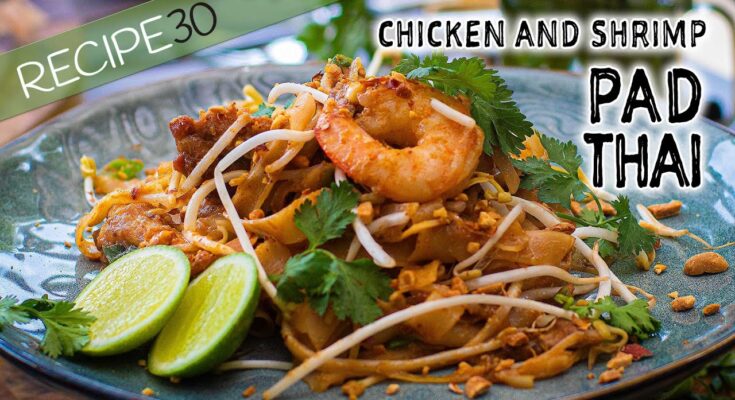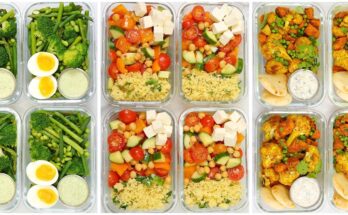Pad Thai Recipe: Pad Thai is one of Thailand’s most iconic dishes. With its unique blend of sweet, sour, salty, and spicy flavors, it has become a favorite across the globe.
Traditionally made with stir-fried rice noodles, eggs, and your choice of shrimp, chicken, or tofu, this dish is topped with fresh garnishes that make every bite irresistible.
Whether you’re a seasoned cook or just getting started in the kitchen, Pad Thai is surprisingly easy to make at home!
Ingredients Required for Pad Thai
Essential Noodles and Sauce Ingredients
- Rice noodles: Choose thin, flat rice noodles (like those used in pho).
- Tamarind paste: This provides the signature sour flavor.
- Fish sauce: A salty ingredient that adds depth to the dish.
- Palm sugar: Helps achieve the sweetness that balances out the sour notes.
- Chili flakes: For a hint of spice (adjust according to taste).
Proteins and Vegetables
- Tofu or shrimp: These are the classic proteins used, though chicken or beef work well too.
- Eggs: Scrambled directly into the noodles for texture and richness.
- Bean sprouts: Add crunch and freshness.
- Garlic and shallots: Essential aromatics that form the base flavor.
- Green onions: Chopped and added at the end for a fresh bite.
Garnishes for the Perfect Finish
- Crushed peanuts: Adds a nutty crunch.
- Lime wedges: A squeeze of lime brightens up the dish.
- Cilantro: Optional, but it adds a refreshing touch.
Kitchen Tools You’ll Need
Having the right tools makes the cooking process smoother:
- Wok or non-stick pan: Ideal for stir-frying.
- Spatula: For flipping and stirring ingredients.
- Mixing bowls: To prep your sauces and ingredients.
- Tongs or chopsticks: Helpful for serving noodles neatly.
How to Prepare for Cooking Pad Thai
- Soak the noodles: Submerge the rice noodles in warm water for about 30 minutes until they soften but remain firm.
- Prep vegetables and proteins: Chop garlic, shallots, and green onions. If using tofu, press it to remove moisture.
- Make the sauce: Combine tamarind paste, fish sauce, palm sugar, and chili flakes. Stir until the sugar dissolves.
Step-by-Step Guide to Cooking Pad Thai
Step 1 – Preparing the Noodles
Once the noodles are softened, drain them and set them aside. They’ll continue to cook slightly during stir-frying, so make sure not to over-soak them.
Step 2 – Cooking the Protein
If using shrimp, cook them in hot oil until they turn pink. For tofu, sear until golden on all sides. Set them aside while you prepare the other ingredients.
Step 3 – Making the Sauce
Warm the tamarind, fish sauce, and sugar mixture in a pan until the sugar dissolves completely. Taste the sauce and adjust if needed—add more fish sauce for saltiness or chili flakes for spice.
Step 4 – Stir-Frying Everything Together
Heat your wok and add a little oil. Start by sautéing garlic and shallots until fragrant. Add the eggs and scramble them briefly. Toss in the soaked noodles, followed by your prepared sauce. Stir quickly to coat the noodles evenly. Add your protein (shrimp or tofu) and bean sprouts. Mix everything together for 2-3 minutes.
Common Mistakes to Avoid When Making Pad Thai
- Overcooking noodles: It’s better to undercook slightly than overcook, as noodles soften further during stir-frying.
- Using the wrong pan temperature: Keep the heat high to prevent soggy noodles.
- Skipping garnishes: Crushed peanuts, lime, and cilantro elevate the dish.
Vegan and Gluten-Free Variations of Pad Thai
- Vegan version: Use soy sauce instead of fish sauce and skip the eggs.
- Gluten-free version: Opt for tamari or gluten-free soy sauce.
Tips for Serving and Pairing
Pad Thai pairs well with fresh cucumber salad or spicy papaya salad. For drinks, try a refreshing Thai iced tea or a chilled glass of white wine.
Storing and Reheating Leftover Pad Thai
Store leftovers in an airtight container in the fridge for up to 3 days. To reheat, add a splash of water to prevent the noodles from drying out and warm them gently on the stovetop.
Health Benefits of Pad Thai Ingredients
- Rice noodles: A gluten-free carb option.
- Shrimp: A great source of protein and omega-3.
- Tofu: Provides plant-based protein.
- Garlic and shallots: Known for their anti-inflammatory properties.
FAQs about Pad Thai Recipe
What are the essential ingredients for Pad Thai?
Pad Thai is a flavorful Thai noodle dish made with flat rice noodles, tamarind paste, fish sauce, eggs, and a combination of tofu, shrimp, or chicken. It’s garnished with peanuts, fresh herbs like cilantro, and lime wedges for an extra zest.
How do I prevent the noodles from sticking together?
To prevent sticking, soak the rice noodles in lukewarm water until they are just soft but still have a bite. This makes them easier to handle when stir-frying. Ensure the pan is hot before adding the noodles and stir constantly to keep them moving.
Can Pad Thai be made vegetarian?
Absolutely! For a vegetarian version, omit the fish sauce and shrimp, replacing them with soy sauce and adding more tofu or introducing other proteins like tempeh.
What can I substitute for tamarind paste in Pad Thai?
If tamarind paste is not available, a good substitute is a mixture of vinegar and sugar. Combine one part vinegar (preferably white or apple cider) with half a part of sugar to mimic the sour and sweet balance of tamarind.
Is Pad Thai gluten-free?
Pad Thai can be gluten-free, but check the labels on sauces like fish sauce and soy sauce as they may contain gluten. Use gluten-free alternatives or tamari instead of traditional soy sauce.
Conclusion
Making Pad Thai at home is easier than you think! With a little preparation, you can enjoy this flavorful dish any time you want. Plus, the ability to customize it with your choice of proteins and spice levels makes it perfect for everyone.
References
For those eager to dive deeper into the delicious world of Pad Thai and explore more about its ingredients, preparation methods, and variations, the following sources offer a wealth of information and authentic recipes:
- Epicurious – Explore a comprehensive guide on how to master the art of traditional Pad Thai, featuring expert tips and variations. Visit Epicurious for more details.
- Serious Eats – Serious Eats provides a detailed exploration of the ingredients and techniques that make a perfect Pad Thai, along with a discussion on regional variations. Learn more at Serious Eats.
- Food Network – Offering a range of Pad Thai recipes from simple home-cooked meals to gourmet versions crafted by top chefs. Check out Food Network’s recipes.
- Saveur – This resource dives into the history and evolution of Pad Thai, giving readers a cultural perspective alongside cooking tips. Read more on Saveur.
These resources are highly recommended for their reliable and in-depth content that can help both novice and experienced cooks perfect their Pad Thai dishes.



